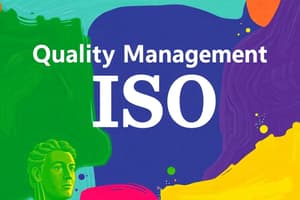Podcast
Questions and Answers
Why is it crucial for organizations to implement a quality management system?
Why is it crucial for organizations to implement a quality management system?
A quality management system ensures consistency in processes, enhances customer satisfaction, and improves overall operational efficiency.
What are the essential elements of a quality management system?
What are the essential elements of a quality management system?
The essential elements include leadership commitment, customer focus, process approach, continuous improvement, and evidence-based decision making.
Briefly describe the historical development of quality principles.
Briefly describe the historical development of quality principles.
Quality principles evolved from early industrial practices in the 20th century, influenced by pioneers like Deming and Juran, who emphasized systematic improvement and customer satisfaction.
How do ISO and CLSI standards relate to quality management systems?
How do ISO and CLSI standards relate to quality management systems?
What role does continuous improvement play in a quality management system?
What role does continuous improvement play in a quality management system?
What is the primary focus of ISO 15189 standards in relation to medical laboratories?
What is the primary focus of ISO 15189 standards in relation to medical laboratories?
What role does top management play in a Quality Management System according to ISO 15189?
What role does top management play in a Quality Management System according to ISO 15189?
Why is it essential for laboratory personnel to have documented qualifications and training?
Why is it essential for laboratory personnel to have documented qualifications and training?
Describe two key components involved in the pre-analytical phase of quality assurance.
Describe two key components involved in the pre-analytical phase of quality assurance.
What is the purpose of conducting internal audits within a Quality Management System?
What is the purpose of conducting internal audits within a Quality Management System?
How do corrective actions contribute to the Quality Management System in a laboratory?
How do corrective actions contribute to the Quality Management System in a laboratory?
In the analytical phase, what is the significance of quality control testing?
In the analytical phase, what is the significance of quality control testing?
What is the PDCA cycle and how does it relate to continuous improvement in laboratory quality?
What is the PDCA cycle and how does it relate to continuous improvement in laboratory quality?
Flashcards are hidden until you start studying
Study Notes
Importance of a Quality Management System
- Ensures consistency in organizational processes, improving efficiency and effectiveness.
- Enhances customer satisfaction by meeting customer requirements and expectations.
- Facilitates compliance with regulatory and industry standards, reducing risks of non-conformance.
- Promotes continual improvement through a systematic approach to managing quality.
- Provides a framework for a structured approach to problem-solving and decision-making.
Essential Elements of a Quality Management System
- Leadership Commitment: Involvement of top management in driving quality initiatives and aligning them with organizational goals.
- Customer Focus: Understanding and addressing customer needs to enhance satisfaction and loyalty.
- Process Approach: Managing activities as processes to achieve desired outcomes and improve efficiency.
- Systematic Management: Integrating various processes and ensuring they work together towards achieving quality objectives.
- Continual Improvement: Regular reviews and audits to identify opportunities for enhancing processes and services.
History of Development of Quality Principles
- Origins trace back to early 20th century with pioneers like Shewhart, who introduced statistical quality control.
- Pioneering contributions by W. Edwards Deming and Joseph Juran in the post-World War II era emphasized quality in manufacturing.
- The establishment of the ISO 9000 series in the 1980s standardized quality management principles globally.
- The evolution of quality management concepts includes Total Quality Management (TQM) and Lean methodologies focusing on customer value and waste reduction.
Relationship to ISO and CLSI Standards
- ISO standards provide a framework for implementing quality management systems across various industries, promoting best practices.
- CLSI standards focus specifically on clinical and laboratory environments, ensuring the reliability and accuracy of test results.
- Both sets of standards emphasize continual improvement and compliance, forming the basis for organizational excellence in quality management.
- Alignment with ISO and CLSI promotes credibility and trust among stakeholders, including customers, employees, and regulators.
ISO 15189 Standards
- ISO 15189 is an international standard for medical laboratories, establishing quality and competence requirements.
- A Quality Management System (QMS) must be created and sustained to align with laboratory functions.
- Top management must show leadership and commitment to the QMS for effective implementation.
- Personnel's qualifications, training, and overall competence are essential to ensure task proficiency.
- Equipment requires proper calibration, maintenance, and validation before it can be utilized in testing.
- Comprehensive documentation, including policies, procedures, and compliance records, is mandatory.
- Regular internal audits are essential for evaluating QMS effectiveness and identifying improvement areas.
- Procedures must be in place to identify non-conformities and implement corrective actions accordingly.
Quality Assurance Processes
- Quality assurance (QA) processes consist of systematic actions aimed at consistently meeting quality standards.
- The pre-analytical phase covers patient preparation, sample collection, and handling to minimize errors.
- The analytical phase focuses on calibration, quality control testing, and validation of test results for accuracy.
- The post-analytical phase emphasizes timely reporting, interpretation, and communication of findings.
- Quality Control (QC) involves using control samples to monitor test result accuracy and precision.
- Continuous review of QC data is critical for detecting trends and addressing outliers.
- The Plan-Do-Check-Act (PDCA) cycle promotes ongoing process improvement.
- Staff and stakeholder feedback is encouraged to identify and address areas needing enhancement.
- Accreditation from recognized bodies is pursued to confirm adherence to quality standards, improving laboratory credibility.
Studying That Suits You
Use AI to generate personalized quizzes and flashcards to suit your learning preferences.




